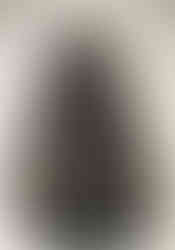1860s Fashion in CDVs
- Ashley Webb

- Jan 14, 2021
- 4 min read

When I found this carte de visite, I fell in love with the unique embellishments on the woman's skirt. Taking a closer look at them now, they seem sort of odd and out of place ruffled ribbons, especially with the one embellishment hanging out on the right proper of her skirt. Because we can't see the entire ensemble, there may be a second ribbon at the left proper hip, too. I suspect this is a case of dressing up an otherwise minimalist solid or lightly striped dress with something more eye catching by sewing extra bits of ribbon in a unique design, or one of the ribbons was used to mend a rip, and it emanated from that. Despite the odd placement of the second ribbon at the hip, it's still lovely.
Her dress is most likely a separate bodice and skirt, accessorized with a belt at the waistline. In the early to mid 1860s, when having an ensemble made typically, the wearer had two bodices made for one skirt - a day bodice, like the one seen here, and an evening bodice, which had short sleeves, a lower neckline, and quite possibly similar and embellishments to those on the skirt. Women didn't have the types of closets or fast fashion we have today, and needed to economize their wardrobe by having some articles do double duty.
If zoomed in, I can't actually tell if it's a ribbon that has been tied into a bow or if it's a belt with another one of the ribbon embellishments just under it, with her watch attached through a button hook, and then draped on the inside of the belt.

With many photographs, the style of sleeves (accompanied by a certain silhouette) can usually identify a time period in which the photograph was taken. The sleeves in this image are called Pamela sleeves - a style of Bishop sleeves that have been tied off at intervals to create puffs. A Bishop sleeve started below the natural shoulder, puffed outward before tapering and tightening at the wrists. Below are some images of different sleeve types seen throughout the 1860s.
Our girl's skirt construction is very typical of the 1860s. With the right type of pleats and the right placement, the skirt lays beautifully over the petticoats and crinolines. You can actually see some of the pleating, as well as a side seam on the skirt. A skirt like this typically uses about 5 yards of fabric, which is then split into four panels and sewn together to the right length. A lining of glazed cotton or linen was typical, and done in the same fashion. At the waist, the fabric is knife and box pleated to the right waist size - changing directions of the pleats at the center front, as well as at the left and right sides in order to get the right draping of the fabric. And it actually looks like she has two sets of box pleats - one at each the left and the right of center at her waist. I'm not 100% positive though.

As far as undergarments, you can actually see easily where her crinoline ends. This is actually a little tidbit I was wondering about with extant garments vs reenactment/historical recreations of undergarments. Whenever I've mounted 1860s dresses with both extant hoops as well as reproduction museum quality crinolines, it's very evident where the crinoline ends, as the outline bottom ring of the hoop is visible under the taffeta and petticoats. Whenever you look at photographs of reenactors, or even in period dramas, you don't see this. I'm wondering if the crinolines are made longer in more modern historical recreations to give the garment and silhouette a smoother appearance. They can't be too long, though, as you've got to be able to walk!
The hoop style - rounded in the front with the emphasis on the back of the silhouette - places this photo around the mid-1860s, as the shape is more elliptical than circular. The 1830s, 40s, and even into the 1850s, you'll see bell shaped skirts, with the skirt size ballooning outward into the early 1860s. By 1862, the skirt shaped moved toward the rear, and even though it's not extremely pronounced in this photograph, it's still evident.

One other cool thing about this image is that I believe she is wearing a snood. A snood is a hairnet that was popular in the early 1860s. The hair was parted down the middle, pulled low over the ears and into a chignon, and the delicate hairnet kept everything tidy and in place. It's really hard to tell though.
Based on all of these, as well as the type of photograph, I'm dating this to around 1863 or 1864. Carte de visites were first developed in 1854 as a photographic calling card, but didn't gain in popularity until 1859. At the outset of the Civil War, they became an inexpensive way to pass to friends or loved ones. The Smithsonian's National Museum of American History recently talked about carte de visites in one of their behind-the-scenes segments, and described just this.
This particular carte de visite was published by Manchester Brothers out of Providence Rhode Island.

They seemed to have a very profitable business, starting with daguerreotype miniatures in the early 1850s. The photographers have been placed in 5 locations, with the location stamped on the reverse of this photograph being occupied between 1861 and 1879. They remained in business until 1895.

























Comments